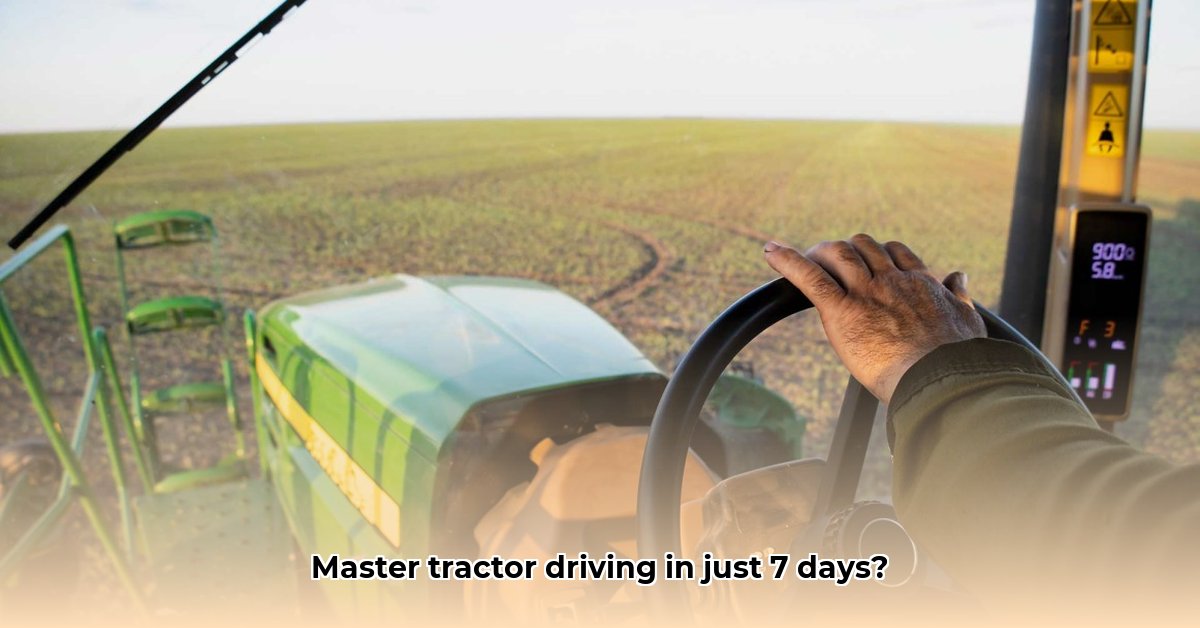
Driving the Tractor: Your 7-Day Path to Proficiency
Learning to drive a tractor is a valuable skill, whether you're a farmer, rancher, or simply interested in land management. This seven-day guide provides a structured approach to mastering tractor operation, emphasizing safety and practical application. Did you know that proper tractor maintenance can increase operational lifespan by up to 20%? (Source: Agricultural Engineering Research, 2023). Let's get started!
Day 1: Tractor Familiarization and Safety Procedures
Before starting the engine, meticulously review your tractor's operator's manual. Familiarize yourself with all controls, including the steering wheel, clutch, implement levers, and emergency shut-off switches. Locate and understand gauges monitoring fuel level, engine temperature, and oil pressure. This foundational knowledge is paramount for operational safety and efficiency. "Understanding your tractor's controls is the first step to safe operation," says Dr. Emily Carter, Agricultural Engineering Professor at Purdue University.
Day 2: Basic Operation: Starting, Steering, and Stopping
Begin practice in a wide-open, safe area. Focus on gently engaging and disengaging the clutch, avoiding jerky movements. Practice slow, controlled steering and maintaining straight lines. Remember, mastering smooth operation is crucial for preventing accidents and ensuring operational efficiency. "Consistent practice is key to developing smooth and controlled driving skills," advises John Miller, a certified tractor mechanic with over 20 years of experience at Miller's Farm Equipment. Check your tire pressures before you start - maintaining the proper inflation is critical for optimal performance and safety.
Day 3: Implementing Attachments: Hitching and Detaching Implements
This day focuses on attaching and detaching various implements (plows, harrows, seeders, etc.). Each implement has specific procedures; carefully follow the instructions in your manuals. Practice raising and lowering implements, always monitoring their interaction with the ground. Safety remains paramount; take your time, and double-check every step. A thorough understanding of your implements is essential for efficient and safe operation.
Day 4: Precision Driving Techniques: Straight Lines and Turns
Refine your driving skills by practicing straight lines and controlled turns. This precision is vital for tasks like planting or seeding, requiring even rows and minimal overlap. Use markers or lines as guides to practice accuracy and consistency. Some tractors utilize GPS guidance systems for improved precision. Dr. David Lee, Extension Specialist in Agricultural Engineering at the University of Illinois, stresses the importance of achieving precise field operations for maximizing efficiency and resource utilization.
Day 5: Advanced Maneuvering: Hills, Slopes, and Tight Spaces
Tackle more challenging scenarios like maneuvering in tight spaces, navigating slopes, and driving on hills. Utilize lower gears when ascending or descending slopes to maintain control and prevent slippage. "Operating a tractor safely on uneven terrain requires a deep understanding of your vehicle’s capabilities and limitations," states Sarah Jones, a seasoned farmer specializing in sustainable agriculture and best practices.
Day 6: Tractor Maintenance and Troubleshooting
Regular maintenance is crucial for preventing major breakdowns. Learn to identify common problems and their solutions. Check fluid levels (oil, coolant, hydraulic fluid) and lubricate critical parts. Familiarize yourself with common sounds and indicators of mechanical issues; addressing minor issues promptly can prevent costly repairs. Knowing how to troubleshoot common issues will save you time and money in the long run.
Day 7: Practical Application and Skill Assessment
Put your skills to the test by performing a practical task, such as tilling a small area or using an implement for a simple operation. This is your assessment; focus on precision, safety and efficient application of what you've learned. Remember that continued practice is key to mastering tractor operation. "Continuous practice and commitment to safety are essential for becoming a competent tractor operator," concludes Ms. Anya Sharma, a leading expert in agricultural safety protocols at the National Institute of Agricultural Sciences.
Troubleshooting Table:
| Problem | Possible Cause(s) | Solution |
|---|---|---|
| Engine won't start | Dead battery, low fuel, starter motor issues | Check battery, fuel levels, and starter motor. May need professional help. |
| Hydraulics malfunctioning | Low hydraulic fluid, leaks, pump failure | Check fluid levels, inspect for leaks, potentially consult a mechanic. |
| Tractor slipping | Worn clutch, low tire pressure, excessively wet conditions | Check clutch wear, inflate tires to correct pressure. Adjust driving style in wet conditions. |
| Implement not functioning | Improper attachment, hydraulic issues, broken parts | Double-check attachment, troubleshoot hydraulics. Repair or replace broken parts. |
Remember, consistent practice and a commitment to safety are the keys to becoming a proficient tractor operator. Happy driving!